Unlock the Secrets to Driving Safe While Towing
March 7, 2023
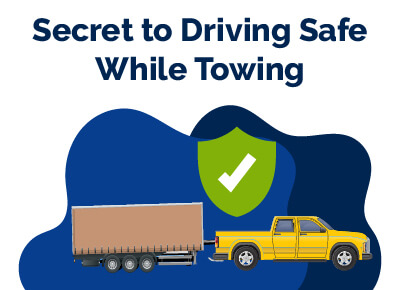

Michael Collado is a car buying expert and has been a professional automotive writer since 2009. He’s written about dealership sales, vehicle reviews and comparisons, and service and maintenance for over 100 national automotive dealerships. Previously, Collado was a copywriter at the ad agency TBWA/Chiat/Day where he worked on brand campaigns for Nissan, ABC Television, Sony PlayStation, and Energizer. His recognition in the ad industry includes awards from Communication Arts and The Clios.
Collado has a Bachelor’s degree from the University of South Florida, with a major in Psychology and a minor in Marketing.
It's important to understand the capacity of your vehicle, as well as hitching and loading the trailer correctly before heading out on the road.
Additionally, you'll need special driving techniques when hauling something behind you, plus safety considerations such as checking tire pressure regularly and doing maintenance checks prior to taking off.
Driving safely while towing requires some key knowledge - let's explore what it takes.
Table of Contents
Towing Capacity
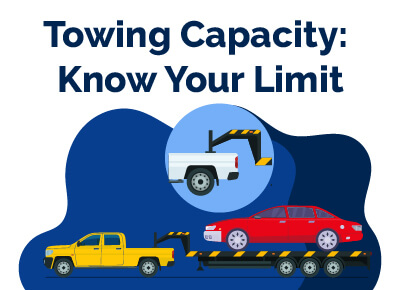 Knowing your vehicle's towing capacity will help you determine the maximum load you can safely tow.
Knowing your vehicle's towing capacity will help you determine the maximum load you can safely tow.
Calculating your vehicle's towing capacity is relatively easy and involves understanding the difference between gross and net weight ratings.
Calculating Your Vehicle's Towing Capacity:
To calculate your vehicle’s towing capacity, start by looking up its Gross Vehicle Weight Rating (GVWR). This number indicates how much weight your vehicle can safely carry, including passengers, cargo, and any additional equipment like a trailer hitch or bike rack.
Once you have this number, subtract the curb weight of your car from it; this will give you an estimate of how much extra weight it can handle in terms of cargo and passengers before exceeding its GVWR. Finally, subtract any additional items that may add more than their own weight, such as bikes or camping gear; this will give you an idea of what kind of trailer size and load you can safely tow with your car.
One way around this problem is opting for lighter materials like aluminum instead of steel, which reduces the overall payload significantly but also costs more upfront.
Key Takeaway: When towing, it is important to understand the difference between gross and net weight ratings in order to calculate your vehicle's maximum capacity. To do this, subtract the curb weight of your car from its GVWR and any additional items like bikes or camping gear that may add more than their own weight. Consider opting for lighter materials such as aluminum instead of steel, which can reduce overall payload but cost more upfront.
Hitching and Loading the Trailer
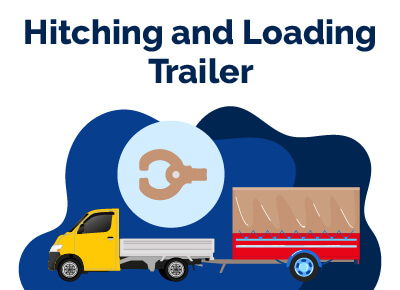 Depending on the size of your trailer, you may need a weight-distributing hitch or a gooseneck hitch. Make sure that you choose one that is compatible with both your vehicle and trailer. Once you have chosen the right hitch, secure it properly to your vehicle using bolts or other fasteners, as recommended by the manufacturer.
Depending on the size of your trailer, you may need a weight-distributing hitch or a gooseneck hitch. Make sure that you choose one that is compatible with both your vehicle and trailer. Once you have chosen the right hitch, secure it properly to your vehicle using bolts or other fasteners, as recommended by the manufacturer.
Next, make sure that all cargo is loaded and balanced correctly in order to prevent swaying while driving. If possible, try to distribute weight evenly between both sides of the trailer so that it remains stable when moving down the road.
Additionally, check tire pressure regularly before each trip, as under-inflated tires can cause uneven wear on them over time and increase fuel consumption due to extra drag from rolling resistance.
Key Takeaway: Ensure safe towing by choosing the right hitch, properly securing it to your vehicle, and loading and balancing cargo correctly. • Choose compatible hitch for both vehicle & trailer • Secure with bolts and fasteners as recommended by manufacturer • Distribute weight evenly between sides of trailer
Driving Techniques
Adjusting Speed for Safe Towing:
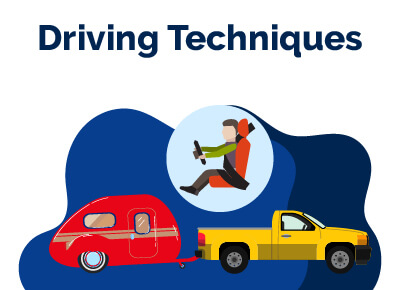 It is recommended that you drive at least 10 mph below the posted speed limit when towing a trailer. This will help ensure that you have enough time and distance to react in an emergency situation.
It is recommended that you drive at least 10 mph below the posted speed limit when towing a trailer. This will help ensure that you have enough time and distance to react in an emergency situation.
Additionally, driving too fast can cause swaying of the trailer, which could lead to loss of control and potential accidents.
Braking Techniques for Trailers:
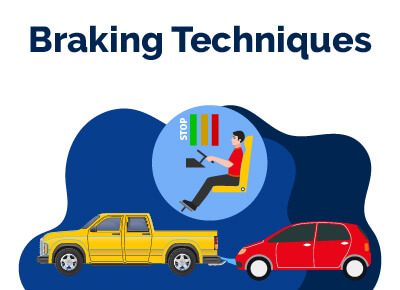 When braking with a trailer attached, it is important not to brake suddenly or harshly as this can cause the trailer's momentum to push forward on the vehicle resulting in jackknifing or, even worse - flipping over.
When braking with a trailer attached, it is important not to brake suddenly or harshly as this can cause the trailer's momentum to push forward on the vehicle resulting in jackknifing or, even worse - flipping over.
Instead, apply gentle pressure on the brakes while slowing down gradually until you come to a complete stop if necessary. If possible, avoid sudden stops altogether by anticipating traffic ahead of time and allowing yourself plenty of space between vehicles so that you don't need hard braking maneuvers while traveling with a trailer attached.
Maneuvering with a trailer attached requires extra caution due to sharp turns or tight spaces as they can cause instability in both your vehicle and the towed load behind it, leading to potentially dangerous situations.
To prevent these from happening, take wide turns when turning corners, keep an eye out for any obstacles such as potholes, curbs, etc., and always maintain steady speeds throughout each turn. Additionally, make sure that all hitches are properly secured before attempting any maneuvering.
Key Takeaway: When towing a trailer, it is important to adjust speed accordingly and brake gently. Maneuvering with a trailer requires extra caution: take wide turns, watch out for obstacles, maintain steady speeds and secure hitches properly.
Safety Considerations
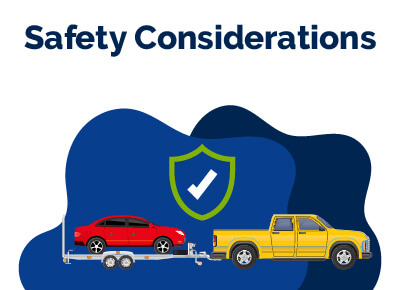 Before each trip, it is essential to inspect the lights, wiring, and connections on both your vehicle and trailer. Make sure all the bulbs are working properly and that there are no frayed wires or loose connections. If any issues are found, they should be fixed before continuing on your journey.
Before each trip, it is essential to inspect the lights, wiring, and connections on both your vehicle and trailer. Make sure all the bulbs are working properly and that there are no frayed wires or loose connections. If any issues are found, they should be fixed before continuing on your journey.
Checking tire pressure regularly is also an important part of safe towing practices. Tires can lose air over time due to temperature changes or road conditions, so make sure you check them often while on the road.
It’s best practice to keep tires inflated at their recommended PSI for optimal performance and fuel efficiency, as well as reduce the risk of blowouts or other tire-related accidents while hauling a heavy load behind you.
Maintenance and Preparation
 It is essential to keep up with regular maintenance on both your vehicle and trailer for safe towing practices. This includes:
It is essential to keep up with regular maintenance on both your vehicle and trailer for safe towing practices. This includes:
- Check fluid levels (oil, transmission, brake, and coolant)
- Inspect brakes, pads, drums, and rotors, for wear or damage
- Make sure hoses are not cracked or leaking fluid
- Replace worn belts
- Lubricate moving parts
- Clean air filters
- Change spark plugs if necessary
- Rotate tires
- Inspect wheel bearings
- Test battery charge
All these steps should be taken regularly in order to guarantee optimal performance from your vehicles while transporting a heavy load behind them.
Key Takeaway: To ensure safe towing practices, it is important to regularly check and maintain your vehicle and trailer: inspect lights, wiring & connections; check tire pressure & wear; check fluid levels; inspect brakes, shoes, drums, and rotors for wear or damage; lubricate moving parts; clean air filters.
Best Car Deals by Category
Frequently Asked Questions
How do you drive while towing?
You should always drive slower than the speed limit and leave plenty of room between yourself and other vehicles on the road. Additionally, when turning or changing lanes, make sure to turn wider than usual in order to avoid any potential issues with the trailer. Lastly, be aware of any additional laws or regulations regarding towing in your area, as they may differ from state-to-state.
How do I protect my transmission while towing?
First, make sure you are using the right vehicle for the job; check your owner's manual for the maximum weight that can be towed safely. Second, use a tow bar or hitch designed specifically for your car and ensure that it is properly installed and secured. Third, always use lower gears when going up hills and accelerate slowly on flat surfaces. Finally, avoid sudden stops or starts as these can cause excessive strain on the transmission and other components of your vehicle.
What gear should I drive in while towing?
Generally speaking, you should drive in a lower gear when towing heavy loads. This will help reduce strain on the engine and transmission while providing better control of the vehicle. When driving uphill, shift into a higher gear as this will provide more power and torque from the engine. On downhill grades, use a lower gear to keep speed under control and avoid excessive wear on brakes.
What should you not do when towing?
It is essential not to exceed the maximum recommended speed limit for your vehicle when towing. Additionally, do not overload the trailer with more weight than what it was designed for, and always make sure that all items are securely fastened down before beginning your journey.
Posted in Car Buying Tips, Uncategorized |




